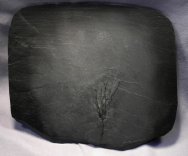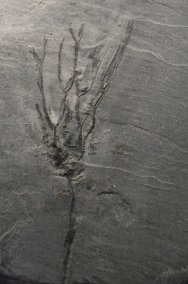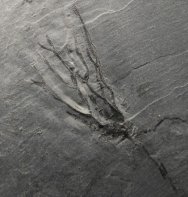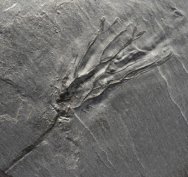Parisangulocrinus
sp
Phylum Echinodermata,
Subphylum Crinozoa, Class Crinoidea, Subclass Cladida (extinct), Family
Dendrocinidae
Geological
Time: Lower Devonian, Seigenian/Emsian Stage
Size (25.4
mm = 1 inch): Calyx: 40 mm tall by 20 mm wide , with 25 mm stem on
a 160 by 135 mm matrix
Fossil
Site: Hunsruck Slate, Bundenbach Germany
Fossil Code:
GF055
Price: Sold
| 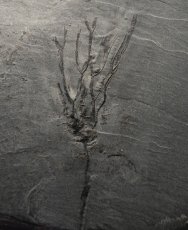 Description:
Well-preserved example of the Cladid crinoid known as Parisangulocrinus
. This family name is derived from the dendritic pattern formed
by the branching arms, clearly seen here. The Hunsruck slate
is famous for its fossils, many of which have pyritization present.
Rapid burial and pyritization was what led to the many wonderful
examples of early Devonian life from the region. The chemistry
of the silt was such that low organic content and high levels
of iron and sulfur allowed the pyrite to diffuse into the tissues
rather than be deposited in the sediment. The mudstones were
metamorphosed into slate during the Carboniferous. The slate
was quarried for roofing tiles, and the quarrymen would save
the fossils for later sale. Now that the quarries are no longer
open, future supplies of these wonderfully-preserved benthic
organisms will only come from existing collections. It is complete
with a portion of attached stem, something not often seen in
an animal that quickly disarticulated after death. Description:
Well-preserved example of the Cladid crinoid known as Parisangulocrinus
. This family name is derived from the dendritic pattern formed
by the branching arms, clearly seen here. The Hunsruck slate
is famous for its fossils, many of which have pyritization present.
Rapid burial and pyritization was what led to the many wonderful
examples of early Devonian life from the region. The chemistry
of the silt was such that low organic content and high levels
of iron and sulfur allowed the pyrite to diffuse into the tissues
rather than be deposited in the sediment. The mudstones were
metamorphosed into slate during the Carboniferous. The slate
was quarried for roofing tiles, and the quarrymen would save
the fossils for later sale. Now that the quarries are no longer
open, future supplies of these wonderfully-preserved benthic
organisms will only come from existing collections. It is complete
with a portion of attached stem, something not often seen in
an animal that quickly disarticulated after death.
|
|

